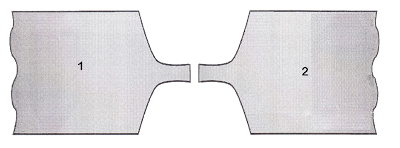Types of Welding Preparation Refer to Standard BS EN ISO 9692
- Open Square Butt Preparation
- Single V Preparation
- Double V Preparation
- Single U Preparation
- Double U Preparation
- Single V Preparation With Backing Strip
- Single Bevel Preparation
- Double Bevel Preparation
- Single J Preparation
- Double J Preparation

Used for welding thin components from one or both sides. If the root gap is zero (ie if components are in contact), this preparation becomes a closed square butt preparation (not recommended due to problems caused by lack of penetration)!

One of the most common preparations used in welding and can be produced using flame or plasma cutting (cheap and fast). For thicker plates a double V preparation is preferred since it requires less filler material to complete the joint and the residual stresses can be balanced on both sides of the joint resulting in lower angular distortion.

The depth of preparation can be the same on both sides (symmetric double V preparation) or deeper on one side (asymmetric double V preparation). Usually, in this situation the depth of preparation is distributed as 2/3 of the thickness of the plate on the first side with the remaining 1/3 on the backside. This asymmetric preparation allows for a balanced welding sequence with root back gouging, giving lower angular distortions. Whilst a single V preparation allows welding from one side, double V preparation requires access to both sides (the same applies for all double sided preparations).

U preparations can be produced only by machining (slow and expensive), however, tighter tolerances give a better fit-up than with V preparations. Usually applied to thicker plates compared with single V preparation as it requires less filler material to complete the joint, lower residual stresses and distortions. Like for V preparations, with very thick sections a double preparation can be used.

Usually this type of preparation does not require a land, (except for aluminium alloys).

Backing strips allow production of full penetration welds with increased current and hence increased deposition rates/productivity without the danger of burn-through. Backing strips can be permanent or temporary. Permanent types are made of the same material as being joined and are tack welded in place. The main problems with this type of weld are poor fatigue resistance and the probability of crevice corrosion between the parent metal and the backing strip. It is also difficult to examine by NDT due to the built-in crevice at the root of the joint. Temporary types include copper strips, ceramic tiles and fluxes.




Types of Welding Preparation Refer to Standard BS EN ISO 9692
 Reviewed by belajar koor
on
7:29 PM
Rating:
Reviewed by belajar koor
on
7:29 PM
Rating:
 Reviewed by belajar koor
on
7:29 PM
Rating:
Reviewed by belajar koor
on
7:29 PM
Rating:










No comments: